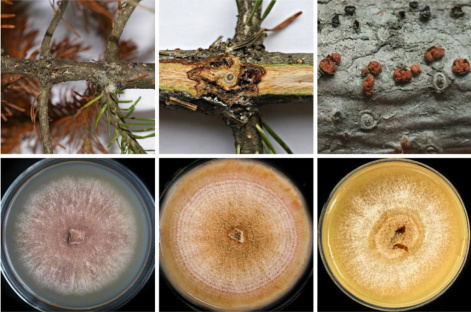A new species of phytopathogenic fungi threatening Siberian fir has been discovered
14 April 2020 г.

Siberian fir is widely distributed in Eurasia and it is an economically valuable species of wood. Krasnoyarsk scientists have identified a new fir disease In the Central Siberia which is manifested by symptoms of trunk deformation, cambium necrosis and death of branches. The characteristic complex of symptoms was first detected in the Eastern Sayan Mountains, and then, 10 years later the disease was detected 450 kilometers to the north. Until recently, the causative agent of the fir disease, its species and origin remained unknown.
A team of scientists from Krasnoyarsk, Sweden and the Czech Republic conducted molecular studies and found that in fungal cankers of Siberian fir there are two new, genetically similar species of ascomycetic fungi. They are part of the recently described group of the genus Corinectria - causative agents of conifer cankers. However, Siberian strains are genetically different from isolates previously found in Chile, Austria, New Zealand, Czech Republic, Slovakia, Scotland and Canada.
“We were able to separate morphologically identical isolates of fungi from the stem and branches of fir with visual signs of cankers into a pure culture and to make a collection of Siberian strains for our study,” says Julia Litovka, one of the authors of the article, Doctor of Biological Sciences, senior researcher at the Laboratory of Forest Cultures, Mycology and Phytopathology at the V.N. Sukachev Institute of Forest KSC SB RAS.
Scientists tested the effect of metabolites and living cultures of fungi on cells and living tissues not only of Siberian fir, but also on ordinary spruce and proved the high phytopathogenicity of new strains. This is a very important result, since the habitat of these conifers intersect in the central part of Russia, which means that there is a likelihood of the spread of the disease to other conifers.
According to the supervisor of the study, professor, Doctor of Biological Sciences, Head of the laboratory of forest cultures, mycology and phytopathology at the V.N. Sukachev Institute of Forest KSC SB RAS, Igor Pavlov, now it is very important to collect as much information as possible about Siberian strains of phytopathogens to describe at least one new species. It is necessary to understand its origin, environment and assess the potential risk of its possible penetration into new geographical areas.
“At the next stage of research, we will try to answer a few questions. To what extent are the Siberian Corinectria strains dangerous for other conifers? Are they native species or invasive fungi of unknown origin and way of penetration? If these are local species, what is the trigger for enhancing their phytopathogenicity? As possible reasons for the latter, we consider global climate change and weakening of stands due to the activation of other pathological factors, for example, root pathogens, ” concludes Igor Pavlov.
Share:
